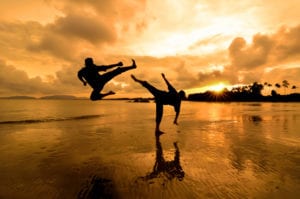Randori is translated to the term “taking chaos ” and it’s the final sparring test before an Aikido student becomes a master. The student starts at one end of the dojo and is given the task to get to the other end. Standing in between the student and the goal are five Aikido masters who attack the student as they progress toward their goal. The student has to defend against multiple attackers in quick succession without being thrown to the floor.
Lately, it can seem like things are coming at us at such a high volume and increased velocity it can feel like we’re taking on chaos on a daily basis, rather than as part of a planned test. This seems to be the unpredictable, dynamic interdependent world we live in now.
Frankly, interdependence always amplifies movement in the system.
Part of this volatile world is human-generated. Another part comes from our outside environment, including nature. Nature is an interdependent system, and we are receiving a lot of feedback from the climate This includes things like:
- Changes in weather patterns
- Rising sea levels
- Drier conditions leading to more frequent and larger fires
- Deluges of rain
- Polar vortexes
- Higher temperatures and more humidity.
These are just some of nature’s indications that our climate is a dynamic interdependent system, and that disruptions are being triggered in our weather systems. We’ve all accepted that increased disruptions have become the norm. There is a silver lining to this fact, however.
All this “practice” we’ve had adapting to the impacts of the pandemic, climate change, civil unrest, and other disruptions is actually strengthening our capacity to live in this world.
Let’s go back to Aikido to dive more into this statement.
Lessons from Aikido
The Randori exercise has three simple rules for a student who aspires to become a master. I believe that these rules also apply to organizational leadership right now:
- Find and keep your center of gravity. When we physically center into our center of gravity it makes it difficult to pull you off-center. Our center of gravity is found physically in the center of our body. We can also be centered through our higher purpose and the deep meaning we have in our lives.
- Take each disruption (attack) as it comes and stay in the mindful moment. It is easy to become overwhelmed with everything that is coming at us these days. Aikido would teach us to stay in the present and focus on responding well to what is coming at us. Mindfulness helps us stay in the present and it also helps us not have our fears of the past or future diminish our capacity to respond.
- Keep moving toward your higher purpose and goals. Our tendency is to freeze when we are caught in a disruptive moment, just like a deer caught in the headlights of a car. The lesson of “keep moving” invites us to continue on our journey and path – to move forward. Joanna Macy’s concept of Active Hope is a form of “keep moving.” She defines active hope as starting with the belief that we have the ability to see a better future and the efficacy to influence that future. Her version of “keep moving” is to wake up every day and act in alignment with the better future you can imagine.
These simple lessons can be applied to our individual and organizational lives. They help us take care of ourselves and to keep moving forward into a better, more regenerative future.







Excellent